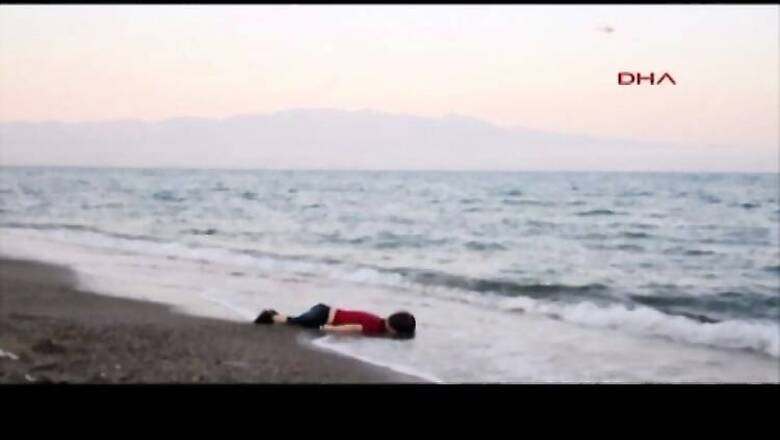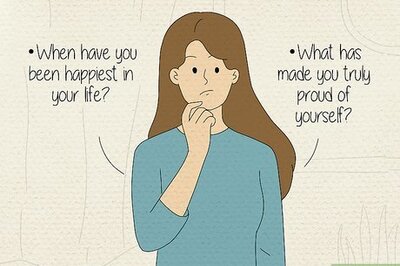
views
…Oh, a boy…not a toy…
The photograph of the 3-year-old Syrian boy, Aylan Kurdi, washed ashore to the Turkish tourist town (beaches, resorts and ancient ruins) is rocking the world: triggering conscience, to act humanely, and making the world to take note of the fact that what happens in another country could affect the neighbouring continent.
The crisis in Syria is a result of Syria becoming a failed state, the growth of ISIS and the lack of will of the international community to find a solution among others. Bashar al-Assad’s regime is helplessly forcing thousands of Syrians to get out of the country to save themselves, and if possible to give a life to their children.
On the promise of smuggler to send them to Europe, Abdullah Kurdi, his wife Rehan and their two children Galip (5) and Aylan (3) set off their journey from Syria―without life jackets―to touch the Mediterranean coast in a dinghy (an inflatable boat) along with others but the dinghy capsized in the Aegean Sea (the nightmare of many migrants, and erstwhile invaders and colonisers). The boat capsized which was supposed to reach the Greek island of Kos on 2 September 2015. Abdullah Kurdi was helpless to save none of this family: wife and two children; he watched them drowning, but the words of his child were: “Daddy, please don’t drown.” Ironically, they drowned; the father survived, and buried them in his war-torn hometown of Kobane in Syria.
Kurdis belong to the Kurdish ethnicity. Kurds are scattered in Turkey, Iran, Iraq and Syria: a nation without a nation state.
…oh, a boy…not a toy…
The three-year-old Aylan’s body was found on the Turkish coast caught the attention of the journalist Nilufer Demir. Feet covered in shoes and attired in blue trousers and red T-shirt lied, Aylan was lying on the shore with his face down, Aylan caught the attention of Nilufer Demir! She filed it to her news agency. Almost every newspaper in the world, every news editor and photo-editor who had come across the image had carried the photograph had published in their newspaper including Indian regional newspapers. It is alive: online, and gaining iconic status. The photograph can move the people (empathy, or sympathy, or both), it has ‘human interest’ element (an illiterate can say looking at the photograph – Oh a baby!). It has become the talking point everywhere…oh, a boy…not a toy…
Cyberspace: Aylan immortalized
An individual, or an entity will exit from the world but the result of Internet is the inerasable sphere called cyberspace. Aylan (Alan) is immortalized with a page dedicated to him on Wikipedia.
His death stirred the governments, countries, executive heads of the countries to react, and also to act. Importantly, the United High Commission for Refugees to step up the campaign to force the Developed World, the European countries, to take refugees.
Who would like to leave their homelands? Refugees are not economic migrants, refugees are not in search of a better lifestyle, and refugees are not in search of opportunities, refugees want to save themselves and their dear and near ones.
The photograph epitomizes the crisis issue of refugees particularly from Syria and heading to the European countries via Turkey (Mediterranean Sea) to Italy, or Hungary. Austria and Germany have relented to take some refugees while Switzerland took a decision to ban the pro-refugee rally (but hoards the black money of the world!).
Canada: world’s second largest country
A migrant, who could be a refugee, could invariably consider Canada as one of the destination countries for migration. It is a large country with a small population of about 3.5 crore. If Canada has any ounce of ambition to emerge as progressive nation, or to emerge as the leading country in the affairs of the world, it should take adequate number of refugees (to have demographic advantage). It is the second largest country in the world after Russia (why Russia is not a destination for migrants and refugees?).
Canada is a nation of immigrants (a colony of the French and British who decimated the aboriginals) with 3.5 crore population. But Aylan Kurdi’s death forced the Canadian Prime Minister Stephen Harper to take 10,000 Syrian refugees in the next four years. However, he did blame the Syrian government and ISIS.
Reactions to the photo:
Non-Western global television channels such as the Russia Today and Al Jazeera are taking a dig at the policies of Europe, and also subtly pointing out their lack of humanitarianism towards refugees. But in a globalized world, it is imperative for regions across the world to be safe, secure, and peaceful, if not?
Great Britain aka the United Kingdom, the mother democracy, has democratized another aspect with the birth of online petitions. The Parliament will debate any issue if there are 100,000 signatories. Its conscientious citizens forced the David Cameron government to rise to the need of the hour: to take Syrian refugees. Reacting to the death of Aylan Kurdi, David Cameron said, “Britain is a moral nation and we will fulfil our moral responsibilities.” Talk was not enough. The UK is under severe criticism for not offering proportional asylum in compared to its European counterparts. But now he is forced to change his stance on accepting refugees to the consternation of conservatives and rightists (who fail to see it, also, as its reparation for the world whose wealth it plundered—check out at British Museum and British Library).
Interestingly, an Egyptian billionaire too reacted to the plight of Syrian refugees. Naguib Sawiris tweeted: “Greece or Italy sell me an island, I’ll call its independence and host the migrants and provide jobs for them building their new country.” Can a debt-ridden and bankrupt Greece take the cue? Economically comatose Italy takes up the offer?
‘Express the scream’:
The photograph of Aylan Kurdi will join the other iconic photographs since the invention of camera: Torture in Abu Gharib Prison in Iran (2004), Army Tanks in Tiananmen Square against the peaceful protestors in China (1989), Shooting of a Viet Cong Officer (1968), 9-year-old Phan Kim Phuc (1972) fleeing during Vietnam War, Alberto Korda’s Che Guevara’s photograph at a memorial in Cuba (1960)…
Aylan Kurdi’s lifeless body reflected the state of affairs in Syria, and also highlighted the plight of refugees and the issue of migration. The photograph of Aylan taken by Nilufer Demir for the Dogan News Agency became world news. In an interview to CNN Turk, Nilufer Demir said she was moved to at the sight of the boy but took the photograph because she wanted to “express his scream”. In death, Aylan Kurdi screamed at the world, and the world rocked.
A photograph is worth a more than a million words.
(Kovuuri G Reddy is the author of ‘Handbook of Journalism and Media: India, Bharat, Hindustan’, he writes on Internet & Indian Media, and Digital Media)


















Comments
0 comment